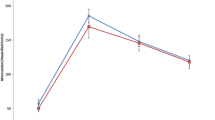Abstract
Purpose
To investigate the possibility of iodine quantification during a single nephrographic phase in characterizing renal cell carcinoma (RCC) subtypes and if there is a difference between areal and volumetric iodine quantification methods.
Materials and methods
This retrospective study included 110 patients with 113 histopathologically confirmed RCCs scanned by dual-energy CT at the nephrographic phase before surgeries. For each lesion, an areal measurement of the iodine concentration with maximum enhancement (I max enhan) and the iodine concentration with maximum area among slices (I max area), as well as a volumetric iodine concentration of the whole-tumor (I volume), were evaluated by two independent radiologists. The diagnostic performances in a single nephrographic phase for characterizing RCC subtypes were evaluated, and three iodine quantification methods were compared with each other.
Results
There were significant differences (clear cell vs. papillary and clear cell vs. chromophobe RCC) and no significant differences (papillary vs. chromophobe RCC) at the nephrographic phase in all three methods. The area under the receiver operating characteristic (ROC) curve (AUC) derived from the I max enhan for discriminating clear cell from papillary RCC was significantly higher than that derived from the I max area (P = 0.0357) and the I volume (P = 0.0206), and no significant differences existed among the three methods in distinguishing clear cell RCC from chromophobe RCC. The reliability of all three parameters was very high with an interclass correlation coefficient (ICC) exceeding 0.8.
Conclusions
Iodine quantification in a single nephrographic phase can be used to differentiate RCC subtypes preoperatively, and the areal maximum enhancement iodine quantification would probably be the most appropriate approach.



Similar content being viewed by others
References
Ljungberg B, Bensalah K, Canfield S, et al. (2015) EAU guidelines on renal cell carcinoma: 2014 update. Eur Urol 67(5):913–924
Srigley JR, Delahunt B, Eble JN, et al. (2013) The International Society of Urological Pathology (ISUP) Vancouver classification of renal neoplasia. Am J Surg Pathol 37(10):1469–1489
Shuch B, Amin A, Armstrong AJ, et al. (2015) Understanding pathologic variants of renal cell carcinoma: distilling therapeutic opportunities from biologic complexity. Eur Urol 67(1):85–97
Leibovich BC, Lohse CM, Crispen PL, et al. (2010) Histological subtype is an independent predictor of outcome for patients with renal cell carcinoma. J Urol 183(4):1309–1315
Vikram R, Ng CS, Tamboli P, et al. (2009) Papillary renal cell carcinoma: radiologic–pathologic correlation and spectrum of disease. Radiographics 29(3):741–754, 755–757
Funakoshi T, Lee CH, Hsieh JJ (2014) A systematic review of predictive and prognostic biomarkers for VEGF-targeted therapy in renal cell carcinoma. Cancer Treat Rev 40(4):533–547
Kutikov A, Smaldone MC, Uzzo RG, et al. (2016) Renal mass biopsy: always, sometimes, or never? Eur Urol 70(3):403–406
Haifler M, Kutikov A (2017) Update on renal mass biopsy. Curr Urol Rep . doi:10.1007/s11934-017-0674-y
Zhang J, Lefkowitz RA, Ishill NM, et al. (2007) Solid renal cortical tumors: differentiation with CT. Radiology 244(2):494–504
Young JR, Margolis D, Sauk S, et al. (2013) Clear cell renal cell carcinoma: discrimination from other renal cell carcinoma subtypes and oncocytoma at multiphasic multidetector CT. Radiology 267(2):444–453
Chandarana H, Rosenkrantz AB, Mussi TC, et al. (2012) Histogram analysis of whole-lesion enhancement in differentiating clear cell from papillary subtype of renal cell cancer. Radiology 265(3):790–798
Neville AM, Gupta RT, Miller CM, et al. (2011) Detection of renal lesion enhancement with dual-energy multidetector CT. Radiology 259(1):173–183
Mileto A, Marin D, Ramirez-Giraldo JC, et al. (2014) Accuracy of contrast-enhanced dual-energy MDCT for the assessment of iodine uptake in renal lesions. AJR Am J Roentgenol 202(5):W466–W474
Kaza RK, Platt JF (2016) Renal applications of dual-energy CT. Abdom Radiol (NY) 41(6):1122–1132
Marin D, Davis D, Roy CK, et al. (2017) Characterization of small focal renal lesions: diagnostic accuracy with single-phase contrast-enhanced dual-energy CT with material attenuation analysis compared with conventional attenuation measurements. Radiology . doi:10.1148/radiol.2017161872
Mileto A, Marin D, Alfaro-Cordoba M, et al. (2014) Iodine quantification to distinguish clear cell from papillary renal cell carcinoma at dual-energy multidetector CT: a multireader diagnostic performance study. Radiology 273(3):813–820
Ng F, Kozarski R, Ganeshan B, Goh V (2013) Assessment of tumor heterogeneity by CT texture analysis: can the largest cross-sectional area be used as an alternative to whole tumor analysis? Eur J Radiol 82(2):342–348
Iwano S, Ito R, Umakoshi H, Ito S, Naganawa S (2015) Evaluation of lung cancer by enhanced dual-energy CT: association between three-dimensional iodine concentration and tumour differentiation. Br J Radiol . doi:10.1259/bjr.20150224
Ascenti G, Mileto A, Krauss B, et al. (2013) Distinguishing enhancing from nonenhancing renal masses with dual-source dual-energy CT: iodine quantification versus standard enhancement measurements. Eur Radiol 23(8):2288–2295
Kim JK, Kim TK, Ahn HJ, et al. (2002) Differentiation of subtypes of renal cell carcinoma on helical CT scans. AJR Am J Roentgenol 178(6):1499–1506
Zarzour JG, Milner D, Valentin R, et al. (2016) Quantitative iodine content threshold for discrimination of renal cell carcinomas using rapid kV-switching dual-energy CT. Abdom Radiol (NY) . doi:10.1007/s00261-016-0967-5
Mori N, Ota H, Mugikura S, et al. (2015) Luminal-type breast cancer: correlation of apparent diffusion coefficients with the Ki-67 labeling index. Radiology 274(1):66–73
Acknowledgments
This study has received funding by the National Science Foundation of Shanghai (Grant No. 14ZR1438400).
Author information
Authors and Affiliations
Corresponding author
Ethics declarations
Conflict of interest
The authors declare that they have no conflict of interest.
Ethical approval
All procedures performed in studies involving human participants were in accordance with the ethical standards of the institutional and/or national research committee and with the 1964 Helsinki declaration and its later amendments or comparable ethical standards. This article does not contain any studies with animals performed by any of the authors.
Informed consent
This retrospective study was approved by the institutional review board and informed consent was waived.
Rights and permissions
About this article
Cite this article
Dai, C., Cao, Y., Jia, Y. et al. Differentiation of renal cell carcinoma subtypes with different iodine quantification methods using single-phase contrast-enhanced dual-energy CT: areal vs. volumetric analyses. Abdom Radiol 43, 672–678 (2018). https://doi.org/10.1007/s00261-017-1253-x
Published:
Issue Date:
DOI: https://doi.org/10.1007/s00261-017-1253-x




